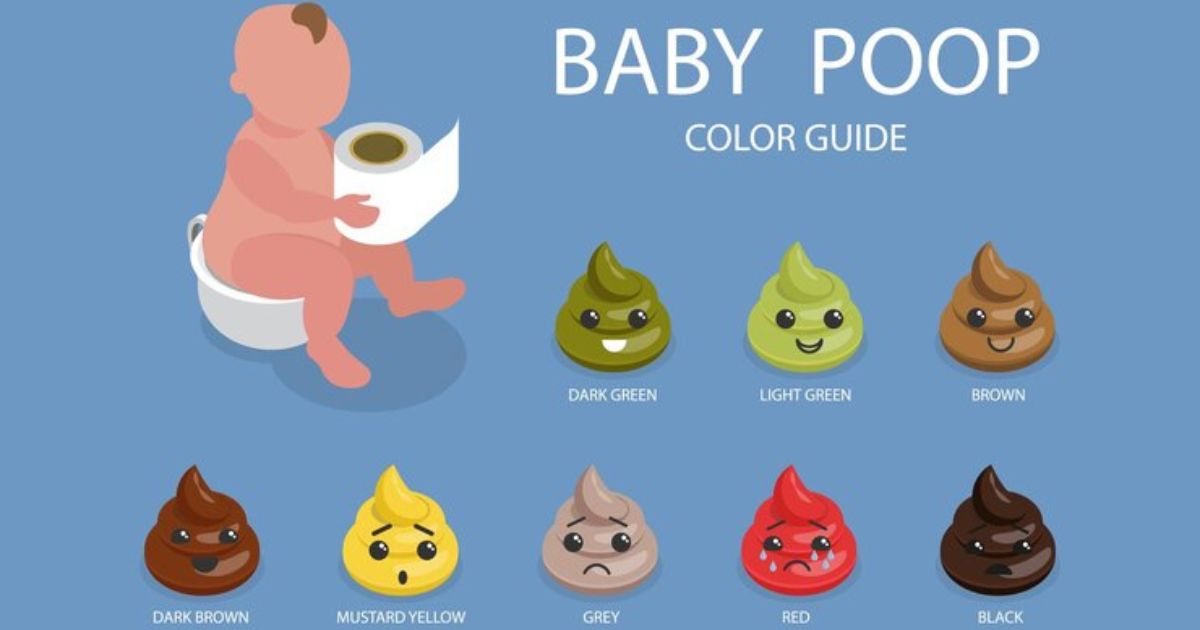Newborn Poop: Color and Consistency Guide
As a new parent, it’s natural to worry about your baby’s health, especially when it comes to their poop. Newborn poop can be weird and its color/consistency will change often. But did you know these variations are also clues to your baby’s overall health? In this article, we shall look at the different colors of newborn poops and their meaning as well.

Normal Newborn Poop Colors
Over the first few weeks, however, baby poop color undergoes several changes. Here’s what to expect:
Black (Meconium)
Meconium — This black or dark brown poop is normal in the first couple of days after birth. It is a viscous, tar-like material containing swallowed amniotic fluid and bile and cell debris from the reabsorbed lining of the digestive tract. There is usually meconium and the stool will become softer, less green in color at 2-4 days of life.
Dark Green/Brown
This is also the reason why new born poop appears green or smelly as they first pass meconium. Meconium combines with bilirubin, a yellow product of liver breakdown in this transitional stool. It typically happens around two to four days after birth, and indicates that the baby’s digestive tract is functioning normally.
Yellow/Brown
Healthy Breastfed Baby: Poop of a newborn baby is yellow or brown in color. It is bilirubin, which decomposed by the liver causes this color. The stool may be loose, watery and frequent; this is normal for a breastfed baby with yellow or brown stools.
Green
Sometimes green poop is normal especially in formula-fed babies or during breastfeeding transitions. But if your baby has consistently green poop — or passes frequent, foul-smelling poo accompanied by other symptoms like: It could imply that the bacteria in your baby’s gut might not be breaking down food correctly, or they may have a common intolerance to formula.
Abnormal Newborn Poop Colors
Some colors require immediate medical attention:
Red/Black
Red or black spots in stool indicate blood, which is a serious concern. Hematochezia (blood in stool) may be due to allergies, infections, or anatomical issues. If you notice blood in your baby’s stool, seek medical attention immediately.
Grey/White
Grey or white stool can indicate liver or gallbladder issues, such as biliary atresia or liver dysfunction. If your baby’s stool appears grey or white, consult a pediatrician promptly.
Pale Yellow/Clay-colored
Pale yellow or clay-colored stool may indicate liver or pancreatic problems, such as hepatitis or cystic fibrosis. Consult a pediatrician if you notice this unusual color.
How Often Will Your Baby Poop?
New babies can poop an awful lot or not much at all, depending on your baby. It is also normal for breastfed babies to pass stool up to many times a day, whether after each feed or two. They poo less frequently than breastfed babies, maybe even every other day or two. Don’t forget that every baby is different, and there’s no set poop schedule, but your babe will get into his groove!
What a diaper might look like if your baby has diarrhea
Symptoms of Baby Diarrhea Once the feeding and teething period is over, The first signs of diarrhea in babies are frequent watery stools and other symptoms such as fussiness, for example, if stooling makes it quite uncomfortable or painful coming out. Every time you change your baby’s diaper and notice that it is watery, do not panic. Yes, this may still be an isolated incident of loose stool. If your baby’s poop is mostly watery, then you need to remove these foods from his diet, and if he is having other suspicious symptoms, then please get in touch with the pediatrician.
Babies: How Long Can They Go Without Pooping?
Breastfeeding babies might go a few days without pooping. Since breast milk is digested fairly easily, there may not be enough leftover waste to make a poop. But if your baby is unable to poop for over a week, definitely call up the pediatrician.

Consistency Guide
- Liquid: (common for breastfed infants).
- Soft: Similar to the formula-fed baby.
- Hard: Can be a sign of constipation.
- Watery: This, too, can be due to infection, and some people also call mucus in their stool “watery.”
Monitor your baby for
- Diarrhea: Frequent, watery stools.
- Constipation: Hard, lumpy stools.
- Blood in stool.
- Mucus in stool.
- Foul odor.
When to Consult a Doctor
Seek medical attention if you notice:
- Blood in stool.
- Persistent diarrhea or constipation.
- Abnormal color or consistency.
- Vomiting or refusal to feed.
- Fever or lethargy.
Conclusion
Newborn poop can be unpredictable, but understanding its color and consistency can provide valuable insights into your baby’s health. Look for abnormal signs and symptoms, and consult your pediatrician if you have concerns.
Additional Tips
- Monitor your baby’s poop frequency and pattern.
- Keep track of feeding and stool changes.
- Consult your pediatrician for personalized advice.